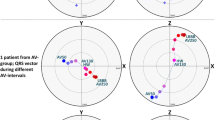Summary
Recent clinical studies have confirmed pathophysiological concepts which suggested right ventriclar pacing to induce ventricular asynchrony and to result in deterioration of systolic and diastolic (left) ventricular function as well as ventricular remodeling. They demonstrated that an increased risk of hospitalization for heart failure and a worsened prognosis were linked to a high cumulative percentage of ventricular stimulation. In antibradycardia pacing for sinus node disease or intermittent AV block, therefore, potential strategies to avoid unnecessary stimulation in the right ventricle may be AAI, low rate (rarely intervening) VVI pacing or some algorithms which discriminate between the feasibility of favoring spontaneous AV conduction and the need for ventricular pacing support while preserving a hemodynamically optimal AV sequence. Competing strategies include AV hysteresis and the switch between AAI and DDD modes which both have shown a considerable reduction in cumulative ventricular pacing rate.
Zusammenfassung
Schon länger bekannte pathophysiologische Konzepte, nach denen die rechtsventrikuläre (vor allem apikale) Stimulation über desynchronisierende Effekte die systolische und diastolische Funktion der linken Herzkammer beeinträchtigt und ein Remodeling mit feinstrukturellen Veränderungen auslösen kann, haben jüngst ihre klinische Bestätigung gefunden, indem gezeigt wurde, dass häufige Kammerstimulation das Risiko der Hospitalisierung wegen Herzinsuffizienz erhöht und die Langzeitprognose beeinträchtigt. Schrittmacher-Patienten mit erhaltener oder nur vorübergehend gestörter AV-Leitung sollte deshalb die Zwangsstimulation in der rechten Kammer erspart bleiben. Geeignete Vermeidungsstrategien sind der AAI-Modus, die niederfrequente und nur bei seltenen Bradykardie-Ereignissen aktive (ventrikuläre) Bedarfsstimulation sowie Algorithmen, die je nach Erfordernis die spontane AV-Leitung favorisieren oder mit optimierter AV-Sequenz stimulieren. Konkurrierende Strategien sind dabei die Variation des technischen AV-Intervalls (Hysterese-Systeme) oder der Moduswechsel zwischen AAI und DDD-Betrieb, welche beide die kumulative ventrikuläre Stimulationsrate deutlich zu senken vermögen.
Similar content being viewed by others
Author information
Authors and Affiliations
Corresponding author
Rights and permissions
About this article
Cite this article
Fröhlig, G. Warum, wann und wie sollte rechtsventrikuläre Stimulation vermieden werden?. Herzschr Elektrophys 15, 165–176 (2004). https://doi.org/10.1007/s00399-004-0428-7
Received:
Accepted:
Issue Date:
DOI: https://doi.org/10.1007/s00399-004-0428-7




